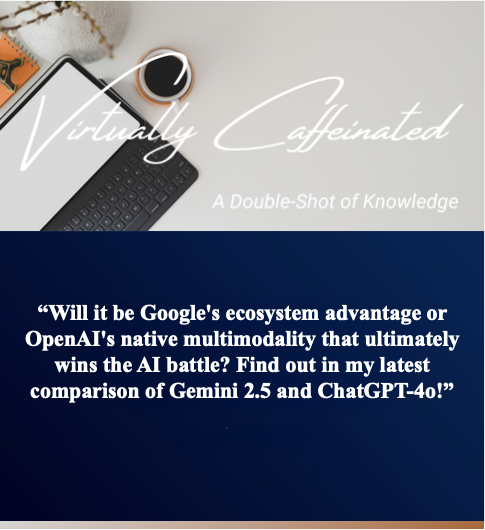Clash of the AI Titans: Gemini 2.5 vs. ChatGPT-4o – Which Reigns Supreme?
The world of artificial intelligence is in constant motion, and the past few months have witnessed the arrival of two formidable contenders vying for the crown of the most advanced large language model: Google’s Gemini 2.5 and OpenAI’s ChatGPT-4o. Both promise significant leaps in capabilities, pushing the boundaries of what’s possible with AI. But how do they truly stack up against each other? Let’s dive into a detailed breakdown of their capabilities, differences, and strengths in various scenarios.
A Quick Overview:
- Gemini 2.5: Building upon the foundation of the already impressive Gemini family, version 2.5 boasts enhanced multimodal understanding, improved reasoning, and a potentially larger context window. Google has emphasized its focus on real-world applications and seamless integration across its ecosystem.
- ChatGPT-4o: OpenAI’s latest flagship model, the “o” signifying “omni,” is designed to be truly multimodal from the ground up. This means it can natively process and generate text, audio, and visual content with unprecedented fluency and coherence.
Detailed Breakdown of Capabilities:
| Feature | Gemini 2.5 | ChatGPT-4o |
| Multimodality | Expected to have significantly improved multimodal capabilities, handling text, images, and potentially audio and video with greater sophistication than previous Gemini models. Strong integration with Google’s visual and audio processing technologies. | Truly native multimodality is a core feature. Excels at seamless integration and generation across text, audio (including voice interaction with human-like prosody), and images. Demonstrates impressive real-time audio processing and response. |
| Reasoning & Logic | Likely to showcase advancements in complex reasoning, problem-solving, and logical inference, building on Google’s strong research in these areas. Expected to perform well in tasks requiring deep understanding and analytical thinking. | Continues to demonstrate strong reasoning and problem-solving abilities, particularly in complex textual tasks and coding. The “omni” model is expected to enhance reasoning across different modalities, for instance, interpreting a chart and explaining its implications verbally. |
| Language Understanding & Generation | Expected to exhibit highly nuanced language understanding and generate coherent, contextually relevant, and creative text across various styles and formats. Strong multilingual capabilities are anticipated. | Maintains its position as a leader in natural language understanding and generation, with further improvements in fluency, naturalness, and the ability to adapt its tone and style. The integration of audio capabilities allows for more natural and conversational interactions. |
| Speed & Efficiency | Google has likely focused on optimizing the model for speed and efficiency, making it suitable for a wider range of applications and devices. | OpenAI has emphasized the speed and efficiency of ChatGPT-4o, making it significantly faster and more cost-effective than its predecessor, while also improving its overall performance. This makes it more accessible for real-time applications. |
| API & Integration | Seamless integration with Google’s vast ecosystem of products and services (Search, Workspace, Android, etc.) is a major strength. Robust API for developers to build applications. | Powerful and widely adopted API, allowing developers to integrate ChatGPT-4o into a multitude of applications and workflows. Strong support for various programming languages and platforms. |
| Context Window | Speculation suggests a potentially larger context window compared to previous Gemini versions, allowing it to process and retain more information from longer conversations or documents. | While the exact context window size may vary, ChatGPT-4o is expected to have a substantial context window, enabling it to handle complex tasks and maintain context over extended interactions. The focus on multimodality might also influence how context is managed across different data types. |
| Personalization | Likely to offer enhanced personalization features, leveraging Google’s understanding of user preferences and context to provide more tailored responses and experiences. | Expected to offer improved personalization capabilities, learning from user interactions to provide more relevant and helpful responses. The multimodal nature could lead to new forms of personalized interactions, such as adapting voice tone or visual presentations. |
Key Differences:
- Native Multimodality: While Gemini 2.5 is expected to be highly multimodal, ChatGPT-4o’s core design emphasizes seamless and native integration across text, audio, and vision from the outset. This could give it an edge in tasks requiring intricate interplay between different modalities.
- Ecosystem Integration: Gemini 2.5 benefits from deep integration with Google’s extensive suite of products and services, offering a potentially smoother experience for users within that ecosystem.
- Real-time Audio Interaction: ChatGPT-4o’s impressive real-time audio processing and human-like voice capabilities set it apart, potentially making it a more natural and intuitive interface for voice-based applications.
- Focus on Speed and Cost: OpenAI has highlighted the significant improvements in speed and cost-effectiveness of ChatGPT-4o, making it more accessible for a wider range of users and applications.
Strengths in Various Scenarios:
- Creative Writing & Content Generation: Both models are expected to excel in generating high-quality creative content. ChatGPT-4o’s multimodal nature might give it an advantage in creating content that blends text, images, and audio seamlessly.
- Coding Assistance: Both are likely to be powerful coding assistants. Gemini 2.5’s potential integration with Google’s developer tools and ChatGPT-4o’s established reputation in this area will make them strong contenders.
- Data Analysis & Interpretation: Gemini 2.5, with its strong reasoning capabilities and potential integration with Google’s data analysis tools, could be particularly strong in this area. ChatGPT-4o’s enhanced reasoning across modalities might also prove beneficial for interpreting multimodal datasets.
- Real-time Customer Service & Chatbots: ChatGPT-4o’s speed, efficiency, and natural audio interaction capabilities could make it a game-changer for real-time customer service and voice-based chatbots.
- Visual Content Creation & Understanding: ChatGPT-4o’s native visual processing capabilities could give it an edge in tasks involving image generation, understanding visual information, and creating visually rich content. Gemini 2.5’s integration with Google’s image processing technologies will likely make it a strong competitor as well.
- Personalized Learning & Education: Both models have the potential to revolutionize personalized learning. Their ability to understand individual needs and adapt their responses could make them invaluable tools for students and educators.
Conclusion: The Choice is Yours (and Depends on Your Needs)
Ultimately, the “better” model between Gemini 2.5 and ChatGPT-4o will likely depend on the specific use case and individual priorities.
- If you are deeply embedded in the Google ecosystem and value seamless integration across its services, Gemini 2.5 might be the more appealing choice.
- If native, highly efficient, and versatile multimodality with a strong emphasis on real-time audio interaction is paramount, ChatGPT-4o could be the frontrunner.
Both models represent significant advancements in AI, and their ongoing development will undoubtedly continue to push the boundaries of what’s possible. As users gain more hands-on experience with both platforms, a clearer picture of their respective strengths and weaknesses will emerge.
What are your thoughts? Which model are you most excited to try? Share your opinions in the comments below!

